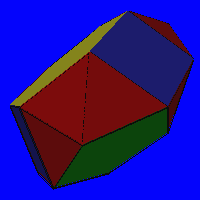Some of the simpler Johnson solids are assemblages of pyramids, prisms, and antiprisms, e.g., a gyrobifastigium is just two triangular prisms glued together with a twist. Others are fragments of Archimedean solids, e.g., a pentagonal rotunda is half an icosidodecahedron and pentagonal cupola is a part of a rhombicosidodecahedron. These can be assembled in various convex ways, e.g., to make a pentagonal orthocupolarontunda or a pentagonal gyrocupolarotunda. They can also be stretched out with a prism to make an elongated pentagonal orthocupolarotunda or with an antiprism to make a gyroelongated pentagonal cupolarotunda. Most of the Johnson solids can be understood as assemblages of simple pieces along these lines.
 Several
Johnson solids are elementary, in the sense that they can not be made as
assemblages of fragments of well-known polyhedra. The snub
disphenoid is one example. Some of these may be somewhat surprising
and one would expect they would be overlooked in a casual attempt to enumerate
all these polyhedra, e.g., the
Several
Johnson solids are elementary, in the sense that they can not be made as
assemblages of fragments of well-known polyhedra. The snub
disphenoid is one example. Some of these may be somewhat surprising
and one would expect they would be overlooked in a casual attempt to enumerate
all these polyhedra, e.g., the
- sphenocorona_(J86)
- sphenomegacorona_(J88)
- hebesphenomegacorona_(J89)
- disphenocingulum (J90)
- bilunabirotunda (J91)
- triangular hebesphenorotunda (J92) (illustrated at right)
They certainly have some great names which one can try to drop in a casual conversation! From the models, you should be able to determine what rotunda, cupola, elongated- and gyroelongated-, augmented- and diminished- each mean. On the remaining terminology, Johnson writes:
If we define a lune as a complex of two triangles attached to opposite sides of a square, the prefix spheno- refers to a wedgelike complex formed by two adjacent lunes. The prefix dispheno- denotes two such complexes, while hebespheno- indicates a blunter complex of two lunes separated by a third lune. The suffix -corona refers to a crownlike complex of eight triangles, and -megacorona, to a larger such complex of 12 triangles. The suffix -cingulum indicates a belt of 12 triangles.Explore the list of all 92 Johnson solids. If you are going to go through the whole set of 92 to try to get to know them, you might find it helpful to think about one or more of the following three questions as you look at each:
Exercise: Look through the entire set of Johnson solids and determine which of them are made from only a single type of polygon.
Answer: Only the ones listed on this page.
Exercise: Look through the entire set of Johnson solids and determine which of them are chiral.
Answer: Surprisingly few are chiral: Only these.
Exercise: Look through the entire set of Johnson solids and determine which of them have more than one axis of symmetry.
Answer: By my count, these.
References: Norman Johnson [1966] published a complete listing of these solids, gave them the names used here, and conjectured that there were no others. Zalgaller [1969] gives a proof that this list is indeed complete. The paper by Martin Berman [1971] gives nets and photographs for making paper models of all 92, and the book by Pugh [1976] has a chapter describing them.